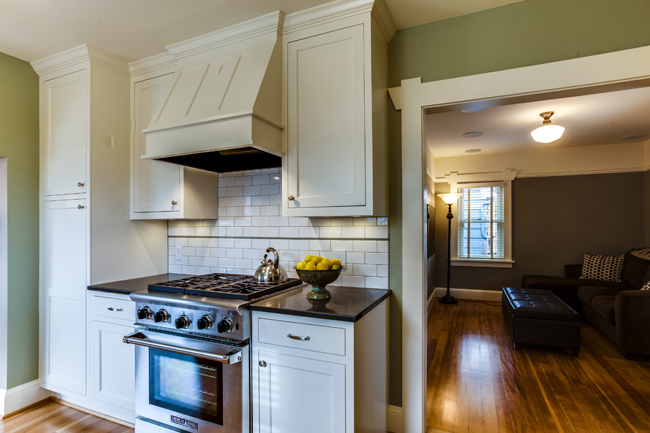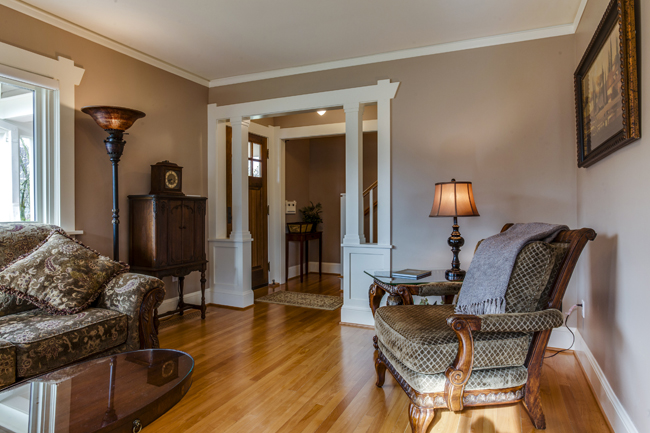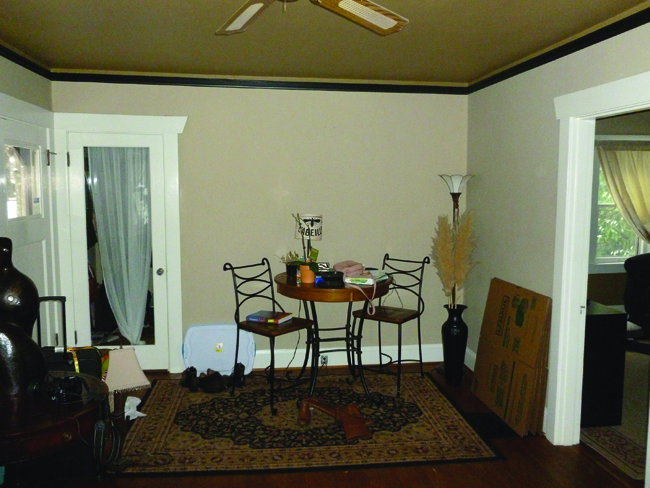The stairwell, formerly accessed by a door at the rear wall, was exposed for an airier entry, further defined by a colonnade. |
Entryway before |
Written by Stacey Green | Photos by Jason E. Kaplan | www.craftmandesign.com
At first glance, some smaller homes seem too cramped for comfort, but with creative collaboration, they can gain a sense of spaciousness and ease. Such was the case with the 1,500-square foot bungalow owned by Scott and Tracey McCulloch.
Unsure of just what kind of fix the home needed, the homeowners turned to Craftsman Design and Renovation, a Portland design- build firm that has built a strong reputation renovating homes similar to theirs.
Craftsman Design demonstrated its full range of design-build skills on the McCulloch renovation, from the initial drawings through wall removals and dormer construction to the finishing work that would seamlessly knit the new construction with the elegance and charm of the original home.
“Our main concern for this project was creating spaces that function for how our clients want to use their home while maintaining the scale, warmth and period style of the home,” said Wade Freitag, owner of Craftsman Design.
Among the most obvious issues Freitag noticed upon an initial home consultation, was the lack of a defined entry, and poorly laid out rooms that felt cramped and dis- connected from one another. He envisioned opening up the home for better flow — improving lighting and sightlines — and a more spacious feel.
Additionally, the bungalow’s second floor felt cut off from the rest of the home, as it was accessed by a narrow stairwell tucked behind a wall off the entry. Removing the wall exposed the stairwell and subtly enlarged the entry space, which was further defined by a colonnade with built-in bookends.
The home’s core was transformed from a series of distinct rooms — living room, dining room, and kitchen — connected by doorways, into a spectacular open corridor where the living room flowed seamlessly into the dining room and kitchen.

The kitchen emerged brighter, airier and roomier as Craftsman Design opened it up to an adjacent underutilized bedroom, which then became a family room. The team replaced dated cabinetry and appliances, and installed a new lighting system.
The McCullochs were excited by the new design. “We never imagined the house flowing this way,” said Scott.
Upstairs, the roof went up as a dormer went in. The space allowed for the addition of a bathroom, thus converting essentially a storage area into a true second floor. Yet, from the street, the home appeared virtually unchanged, save for the dormer wings flanking the second-floor window.
Throughout the project, Craftsman Design retained the look and feel of the home’s original interior. Existing features were retained when possible, or repurposed. One example: the main-floor door that had hidden the stairwell came upstairs, where it was fitted into a jamb and revised to match the rest of the doors. Workers reused and restored existing cabinets, millwork and trim, doors and hardware,and floors.
Once cramped rooms now open into each other,
|
The renovation included energy-saving upgrades, such as a high-efficiency, on-demand water heater, high-efficiency furnace, and Energy Star appliances. LED bulbs went into the period-style lighting fixtures. Insulation was bolstered, and the entire building shell was air sealed.
Craftsman Design’s commitment to green practices can be found throughout the renovated home. The design incorporates as much of the existing structure and components of the home as possible, thus saving existing resources.All the old appliances, plumbing fixtures, cabinets, windows, doors, and any other useable building parts were donated to a salvage center for re-use, while construction debris was sorted and recycled.
Additionally, the firm used locally sourced DeWils cabinets made from certified sustainably harvested wood and low-VOC finishes.
As for the McCullochs, they were elated with both the process and the results.
“Everything that they came up with to bring it back to that period was basically their inspiration to us,” Scott said. “They got us excited about it. They gave us what we wanted—we just didn’t know what we wanted until they showed it to us.”






